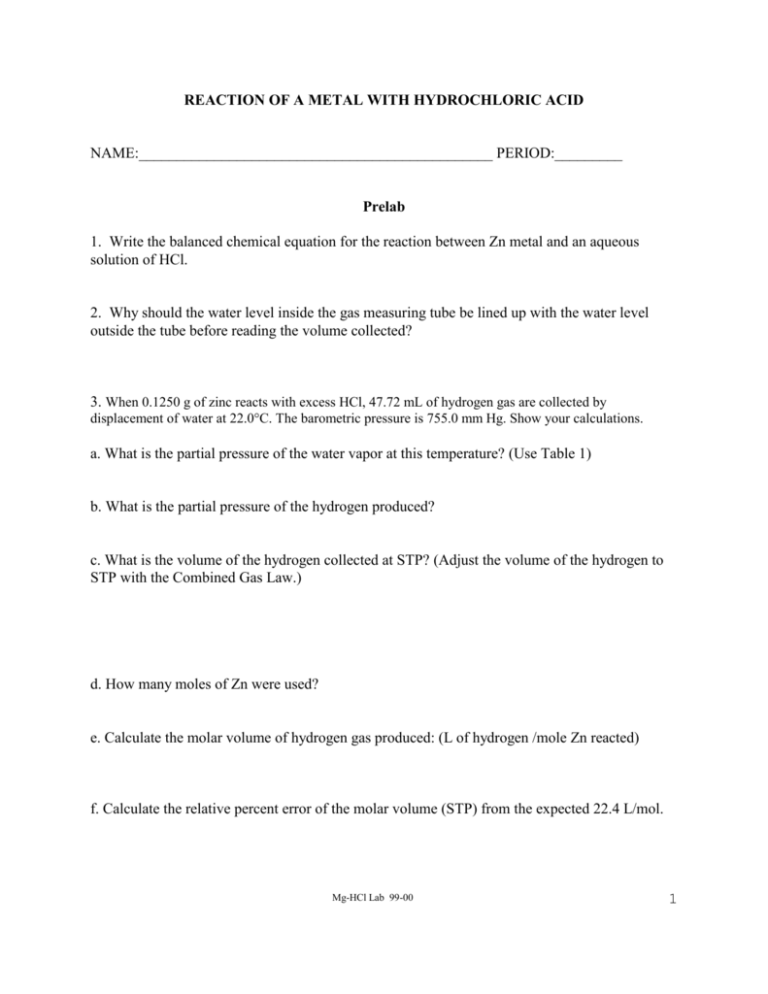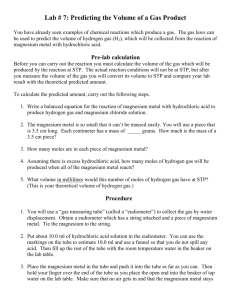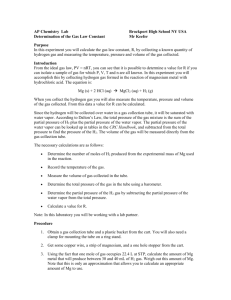Molar Volume at STP Lab Document
advertisement

REACTION OF A METAL WITH HYDROCHLORIC ACID NAME:_______________________________________________ PERIOD:_________ Prelab 1. Write the balanced chemical equation for the reaction between Zn metal and an aqueous solution of HCl. 2. Why should the water level inside the gas measuring tube be lined up with the water level outside the tube before reading the volume collected? 3. When 0.1250 g of zinc reacts with excess HCl, 47.72 mL of hydrogen gas are collected by displacement of water at 22.0°C. The barometric pressure is 755.0 mm Hg. Show your calculations. a. What is the partial pressure of the water vapor at this temperature? (Use Table 1) b. What is the partial pressure of the hydrogen produced? c. What is the volume of the hydrogen collected at STP? (Adjust the volume of the hydrogen to STP with the Combined Gas Law.) d. How many moles of Zn were used? e. Calculate the molar volume of hydrogen gas produced: (L of hydrogen /mole Zn reacted) f. Calculate the relative percent error of the molar volume (STP) from the expected 22.4 L/mol. Mg-HCl Lab 99-00 1 THE REACTION OF A METAL WITH HYDROCHLORIC ACID Abstract: The reaction of magnesium metal with an aqueous hydrochloric acid solution is carried to completion to verify the stoichiometric relationship proposed. Objective: Objectives in this lab are to verify the relationship between the number of moles of the reactant magnesium and moles of hydrogen product, to determine the molar volume of an ideal gas at STP and to calculate a value for the ideal gas constant, R. Introduction: One mole of any substance contains 6.02x1023 units of that substance. If that substance is a gas, one mole occupies 22.4 liters at Standard Temperature and Pressure (STP: 273.15 K and 1.00 atm). In this experiment you will react a measured mass of magnesium metal with an aqueous solution of hydrochloric acid, producing soluble magnesium chloride and hydrogen gas. Mg (s) + 2 HCl (aq) MgCl2 (aq) + H2 (g) The volume of hydrogen gas, under non-standard conditions, will be determined by reacting a measured mass of magnesium metal with aqueous hydrochloric acid solution. After correction to STP, if the volume of H2 per mole of Mg is close to 22.4 L, then the stoichiometry of the reaction, as indicated in the above equation, can be considered verified. Procedure: 1.Mass a strip of Mg metal (approximately 5 cm long) on an analytical balance. Handle the metal with a paper towel to avoid depositing grease from fingers. 2.Bend the metal strip and encase in a spiral cage of copper wire, leaving about 5 cm of wire to use as a handle. 3. Use a 50.00mL gas measuring tube for the measurement of the volume of wet gas produced by collecting the gas by displacement of water. Be careful not to drop or hit the gas measuring tube to anything (the rim chips easily). 4. Incline the tube slightly from an upright position and pour in 10mL of 6 M HCl. The acid is the excess reactant so it isn't critical that you use exactly 10mL of the acid. 5. With the tube still inclined, slowly and completely fill the tube with water from a wash bottle. Use the water to rinse any acid that may be on the sides of the tube so that the liquid in the top of the tube will contain very little acid. Avoid mixing the acid layer in the bottom of the tube with the less dense water above it. The bubbles adhering to the sides of the tube can be dislodged by gently tapping the tube with your finger. 6. While holding the copper coil by the handle insert the metal about 3 cm down into the tube. Mg-HCl Lab 99-00 2 Bend the end of the copper wire over the edge of the tube and place your index finger over the completely filled tube. Invert the tube in the beaker of water. Rest the mouth of the tube on the bottom of the beaker and clamp the tube to the ring stand. The acid is denser than water and will flow down through it and react with the magnesium metal (the copper does not react with the acid although its oxide layer will be removed). 7. After the reaction is completed (bubbles stop forming), wait 5 minutes to allow the tube to come to room temperature. Dislodge any bubbles clinging to sides of the tube. (You probably will not be able to get rid of all of them). 8. Cover the open end of the test tube with your finger and transfer the inverted tube to a large water bath that is almost filled with water. Raise or lower the tube until the level of the liquid inside the tube is the same as the level outside the tube. This allows you to measure the volume of gases in the tube (hydrogen gas and water vapor) under the conditions where the total pressure inside the tube equals atmospheric pressure. Read the bottom of the meniscus with your eye at the same level as the liquid inside the tube. Read the volume graduations to the nearest 0.05mL. 9. Remove the gas measuring tube from the water and pour the dilute acid and magnesium chloride solution into the sink. Rinse the tube and the beaker with tap water. 10. Record the room temperature, the water bath temperature and atmospheric pressure (PTotal = barometer reading). 11. Repeat the experiment, checking the barometric pressure, room temperature, and the water bath temperature. If both temperatures are the same, then you may use this temperature to look up the vapor pressure of water as well as in the volume correction to STP. Otherwise the room temperature is used in the volume calculation, since the gas will be at room temperature. The bath temperature should be used to determine the vapor pressure of water, since the water inside the gas measuring tube is at the water bath temperature. 12. Determine the vapor pressure of the water. The values in Table 1 may require interpolation if your temperatures are not integer degrees. For example, if your bath was 15.3°C, from the table you can see that at 15.0°C water has a vapor pressure of 12.8 mm Hg and at 16.0°C water has a vapor pressure of 13.6 mm Hg. The difference between the two vapor pressures for a whole degree change in temperature is (13.6)-(12.8)=0.8. We want the vapor pressure at 15.3°, not 15.0°C or 16.0°C. Multiplying this difference by the fractional increment, 0.3, gives us 0.2 mm Hg (0.3 x 0.8 = 0.2 to one sig. fig.). Adding this to the vapor pressure at 15.0°C gives us 13.0 mm Hg for the vapor pressure of water at 15.3°C. 13. According to Dalton’s Law of Partial Pressures, PTotal PH2 PH2 O . Calculate the partial pressure of the hydrogen. 14. Using the Combined Gas Law with T1 = the room temperature of the gas, V1 = the volume of gas at room temperature, and P1 = the partial pressure of the dry hydrogen, calculate the volume Mg-HCl Lab 99-00 3 of the hydrogen at STP. 15. Convert the volume of the hydrogen at STP to liters 16. The moles of H2 are equal to the moles of Mg since they are in a 1:1 mole ratio in the balanced equation. Calculate the molar volume of H2 at STP by dividing the liters of hydrogen at STP by the moles of Mg. 17. Calculate the percent error in the molar volume: %Error Experimental .Value. 22.4L / mol x100 22.4L / mol 18. Calculate an experimental value of R in L atm/ mol K. Use PV= nRT with T = the room temperature of the gas converted to K, V = the volume of gas at room temperature converted to L, P = the partial pressure of the dry hydrogen converted to atm., and n = moles of H2. Table 1. VAPOR PRESSURE OF WATER AT VARIOUS TEMPERATURES TEMPERATURE (°C) 15 16 17 18 19 20 21 22 23 24 25 26 27 28 29 30 VAPOR PRESSURE (mm Hg) 12.8 13.6 14.5 15.5 16.5 17.5 18.6 19.8 21.0 22.4 23.8 25.1 26.7 28.2 30.0 31.8 Mg-HCl Lab 99-00 4 THE REACTION OF A METAL WITH HYDROCHLORIC ACID NAME:____________________________________________ PERIOD:_________ LAB PARTNER:____________________________________ DATE:___________ Data Table Trial 1 Trial 2 Mass of metal (Mg) strip g g mL mL o o o o Volume of gas, (H2 and H2O vapor) at room Temp. Room Temperature C Temperature of the Water Bath C C C Barometer reading,(Ptotal) mm Hg mm Hg mm Hg mm Hg mol mol mm Hg mm Hg mL mL L L L/mol L/mol % % L atm/mol K L atm/mol K Vapor pressure of water at the water bath temp. Moles of Mg used Partial Pressure of Hydrogen Volume of dry hydrogen gas corrected to STP Volume of dry hydrogen gas corrected to STP Volume of H2 (STP) per mole of Mg Relative Percent Error in the Molar Volume Experimental Value for R Mg-HCl Lab 99-00 5 Calculations: Conclusions: Discuss briefly the magnitude of the difference between your experimental molar volume and the expected value (22.4 L/mol). Does your result verify the 1:1 stoichiometry of Mg:H2? Explain what measurement error (s) might have caused the inaccuracy of your result. Mg-HCl Lab 99-00 6







